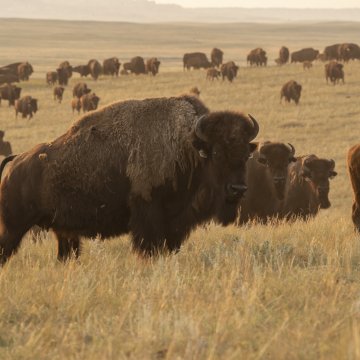By Kansas Reflector - 9/1/2022
Decades of research led by scientists at Kansas State University offered evidence reintroducing bison to roam the tallgrass prairie gradually doubled plant diversity and improved resilience to extreme drought.
Gains documented in the journal Proceedings of the National Academy of Science were among the largest recorded globally in terms of species richness on grazing grasslands. The research involved more than 30 years of data collected at the Konza Prairie Biological Station near Manhattan.
Zak Ratajczak, lead researcher and assistant professor of biology at Kansas State, said removal of nearly all bison from the prairie occurred before establishment of quantitative records. That meant effects of removing the dominant grazer were largely unknown, he said.
“Bison were an integral part of North American grasslands before they were abruptly removed from over 99% of the Great Plains,” Ratajczak said.
The research took place in the Flint Hills ecoregion, which is the largest remaining landscape of tallgrass prairie. Researchers examined plant composition and diversity on sections of land with no mega-grazers present, with bison allowed to graze throughout the year and with domestic cattle allowed to graze during the growing season.
“Our results suggest that many grasslands in the central Great Plains have substantially lower plant biodiversity than would have occurred before bison were widely wiped out,” Ratajczak said. “Returning or ‘rewilding’ native megafauna could help to restore grassland biodiversity.”
The study confirmed cattle had a positive impact on plant diversity, compared to having no large grazers present. The increases with cattle in terms of plant species richness were significantly smaller than those related to bison.
Along with addressing land use, researchers sought to understand how bison influenced plant resilience to climate extremes. Because of the duration of the study, researchers were able to capture one of the most extreme drought events that has occurred in the Great Plains since the Dust Bowl of the 1930s.
“The resilience we found in the bison grasslands is also consistent with the idea that diversity promotes ecological resilience,” Ratajczak said. “And this resilience will only become more important if our climate becomes more extreme.”
Other K–State biology researchers on the study were Jesse Nippert and John Blair, professors; Allison Louthan, assistant professor; and Jeffrey Taylor, research assistant. Additional collaborators included Scott Collins, University of New Mexico; Sally Koerner, University of North Carolina; and Melinda Smith, Colorado State University.
“Some of the most meaningful ecological trends take decades to unfold,” Nippert said. “Without this type of data, fundamental properties of ecosystems may go unnoticed using only short-term A series of six grants totaling more than $31.6 million since 1980 from the National Science Foundation funded the study and was conducted as part of the NSF Long-Term Ecological Research, or LTER, program.
“The research done at the Konza Prairie is truly unique and impressive, ” said David Rosowsky, K–State vice president for research. “There are very few locations in the world that can provide this type of long-term data that can have such a strong impact on how we interact with our natural resources.”
The Konza Prairie Biological Station is jointly owned by Kansas State University and the Nature Conservancy.
The Kansas Reflector is part of the States Newsroom, a network of similar news bureaus supported by grants and a coalition of donors as a 501c(3) public charity.














